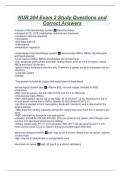NUR 504 Exam 2 Study Questions and
Correct Answers
Purpose of the hematologic system ✅-blood formation
-transport of O2, CO2, metabolites, nutrients and hormones
-involved in immune reactions
-hemostasis
-acid-base balance
-fluid balance
-temperature regulation
components of the hematologic system ✅-blood (solids-RBCs, WBCs, thrombocytes
and liquid-plasma)
-bone marrow (RBCs, WBCs and platelets are formed here)
-liver (produces prothrombin and other clotting factors such as Vit K formation, stores
RBCs and extra iron/ferritin)
-spleen (major antibody production site. Those w/o a spleen are at an increased risk for
infection).
-lymphatic system
-kidneys
*This system includes all organs that make blood or store blood
hematological system labs ✅-Vitamin B12, iron and copper (needed for RBC
production)
-RBC normal values= 4.6-6.3x106/mm3 M and 4.2-5.4x106/mm3
-reticulocytes (baby RBCs)
-H&H (Hemoglobin carries O2 t/o the body. M 14-18 and F 12-16. Hematocrit is the %
of your blood volume that is RBCs. Usually 42-52% M and 37-47% F).
-iron (this is needed to form hemoglobin, binds with transferrin and is absorbed in the
small intestine)
-TIBC (total iron binding capacity) and ferritin: determines how much iron is stored in the
body
-WBC (neutrophils, basophils and eosinophils)
-platelets: should be 105,000-400,000. 20% are stored in the spleen, short lifespan and
function is to decrease blood loss by clotting.
-clotting related labs: PT (11-12.5 seconds), INR, aPTT (30-40 seconds and 1.5-2.5
times control value if pt is on heparin therapy) and fibrinogen (200-400)
abnormal hematocrit levels ✅Low: may be d/t a chronic illness such as cancer, anemia
or blood loss.
High: may be d/t dehydration or polycythemia vera
abnormal iron levels ✅high: d/t hep B or a vitamin deficiency
, low: low iron consumption, blood loss or absorption deficiency
clotting cascade ✅This is a series of events that leads to hemostasis. This prevents
blood loss and promotes healing. It is activated d/t blood vessel injury or damage.
-Platelets are first to arrive and stick to the damaged BV and recruit more platelets to
the site.
-fibrin is a sticking substance used to create the platelet plug
-plasmin is a a protein and digests fibrin
1)Platelet finds exposed collagen of damaged vessel 2) Platelet releases chemical that
causes neighboring platelets to adhere to each other (platelet plug) 3)collected platelets
and damaged tissue both released thromboplastin
4) Thromboplastin and calcium and vit.K converts inactive prothrombin to its active form
thrombin
5) Thrombin converts fibrinogen into fibrin
6) fibrin threads coat damaged area and trap blood cells to form clot
nursing actions for the hematological system ✅Ask pt. about drug use, diet, alcohol
use, age, sex, liver fxn, s/sx of liver problems, PMH, hemophilia, jaundice, JVD, tongue
changes (smooth and beefy=pernicious anemia), paresthesia, bruising, sickle cell
disease, nose bleeds, med hx, hemorrhages, heavy menstrual cycles, lymph node
swelling, excessive bruising, SOB upon exertion, infection, HA, fever, weight loss,
paresthesia, edema, arrhythmias, proteinuria, hematuria, GUAC, assess CNS.
Heparin-induced thrombocytopenia (HIT) ✅Def: Severe complication d/t heparin
exposure and results in an unexplainable decrease in platelets (thrombocytopenia). This
leaves patients in a hypercoagulable state (increased risk of clots) and a thrombosis
(blood clot that blocks BV) can occur.
Patho: PF4 (stored in platelets and is released upon activation) binds to heparin and
results in IgG, IgA or IgM.
Cause: Type 1=non-immune mediated. This is mild and platelets can recover on their
own. Type 2=immune antibody mediated. This is severe and life-threatening.
Risk factors: (Occurs in about 5% of patients who have received heparin) Increased
dose of heparin, increase duration of tx, females, elderly and surgical patients.
Sx: unexplained drop in platelets, H&H remain stable, have had heparin in the last 5-10
days or are on heparin currently, enlarged/extended/new thrombus (DVE/PE), pain,
swelling or redness at the injection site, weakness or pain with movement.
Dx: HIT score, PF4 ELISA (if negative than no HIT) and explained decrease in platelets




